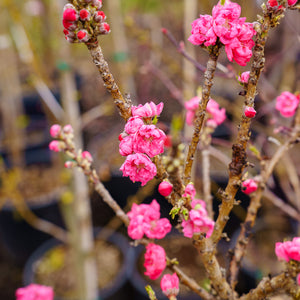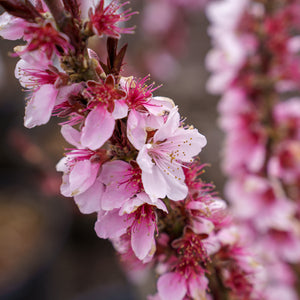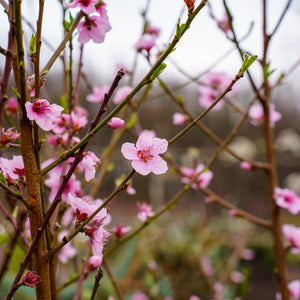The Peach Tree Guide
Peach trees bring a delightful and timeless presence to any landscape. With their graceful form, blossoming flowers, and bountiful fruit, peach trees capture attention and infuse gardens and outdoor spaces with beauty and productivity. These remarkable trees are admired for their versatility and can flourish in diverse conditions when provided with appropriate care and maintenance. Whether you aim to create a serene orchard getaway or desire a striking centerpiece for your garden, peach trees are an outstanding choice.
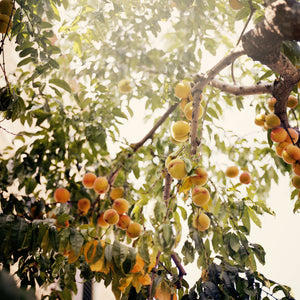
About
Peach trees, members of the Prunus genus, encompass various deciduous trees known for their captivating presence and horticultural significance. With numerous recognized species, peach trees thrive in temperate regions, and they're cultivated extensively in many parts of the world, including North America, Europe, and Asia. These splendid trees are characterized by unique attributes and their essential role in producing delectable fruit.
One of the distinctive features of peach trees is their stunning blossoms, which adorn their branches with vibrant colors during the spring. Their leaves are typically lance-shaped and possess serrated edges, showcasing shades of green during the growing season. As summer matures into fall, peach trees offer a magnificent display of foliage, with leaves transitioning into warm hues of yellow, orange, and red.
Peach trees are celebrated for their horticultural significance, bearing an abundance of sweet, juicy fruit that delights both people and local wildlife. In spring, they exhibit delicate pink blossoms, attracting pollinators like bees and other beneficial insects. The fruit, encased in a fuzzy skin, is a valuable food source for various creatures.
These adaptable trees can thrive in diverse soil types and environmental conditions. They prefer well-drained soil, and they flourish when exposed to full sun. However, they also exhibit tolerance to different soil conditions and can adapt to varying climates. Their moderate growth rate and the bounty of fruit they produce make peach trees a coveted choice for orchards and home gardens.
Whether you desire a productive fruit tree in your garden, intend to cultivate an orchard, or simply want to enjoy the beauty and taste of peach fruit, peach trees provide an element of charm, flavor, and horticultural significance to any landscape. Some popular peach tree varieties include the Elberta and Redhaven, known for their luscious fruit and appealing appearance. By selecting and nurturing peach trees in your garden, you not only enhance your outdoor space's visual appeal but also indulge in the delicious harvest they offer.
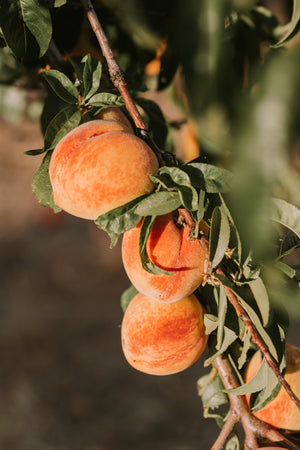
Planting
Peach trees have specific requirements for successful planting and growth. Here are some general guidelines for planting and caring for peach trees:
Soil: Peach trees thrive in well-drained soil that is rich in organic matter. They prefer slightly acidic soil with a pH between 6.0 and 7.0. To prepare the planting site, loosen the soil and incorporate compost or organic matter to enhance drainage and fertility.
Sunlight: Peach trees require full sun, so choose a location that receives at least six hours of direct sunlight each day. While they thrive in full sun, they can tolerate some partial shade, which is especially useful in hot and arid climates.
Watering: Proper watering is essential, especially during the initial establishment of peach trees. After planting, water deeply to help the tree settle, and continue to provide regular irrigation throughout the first year. Aim for deep and thorough watering once or twice a week, depending on rainfall and soil moisture levels. Avoid overwatering, as excessive moisture can lead to root problems.
Mulching: Apply a layer of organic mulch around the base of your peach tree to conserve moisture, inhibit weed growth, and regulate soil temperature. You can use materials like wood chips, bark, or compost for mulch. Ensure the mulch is a few inches away from the tree's trunk to prevent excess moisture around the base.
Pruning: Peach trees benefit from regular pruning to maintain their shape and encourage healthy growth. Typically, pruning is done during late winter or early spring while the tree is dormant, before new growth begins. Focus on removing dead, damaged, or crossing branches to establish a strong and balanced framework.
By following these fundamental planting and care recommendations, you can ensure the successful establishment and healthy development of your peach trees, allowing them to thrive and produce delicious fruit while enhancing the beauty of your landscape for years to come.
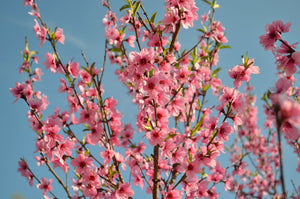
Care
Peach trees require specific care to ensure their optimal growth and health. Here are some general guidelines for the care of peach trees:
Watering: During the growing season, it's crucial to provide adequate watering to your peach trees. Aim to supply about one inch of water per week, but adjust this amount as needed based on rainfall and weather conditions. It's essential to water deeply and thoroughly to encourage deep root growth. Shallow watering can cause stress and dehydration in the trees. In periods of drought or high temperatures, you may need to provide additional watering to maintain the soil's moisture.
Pruning: Peach trees typically require regular pruning to maintain their health and desired shape. While extensive pruning is not usually necessary, it's advisable to remove any dead or damaged branches. Additionally, you can shape the tree to achieve the desired size and form. Pruning is most effective when done during late winter or early spring before new growth begins. Use clean, sharp pruning tools to minimize the risk of harming the tree. Deadheading spent flowers can also encourage new growth and potentially lead to a second blooming.
Fertilizing: Fertilizing can significantly impact the growth and fruit production of peach trees. Apply a balanced, slow-release fertilizer in the spring or early summer following the manufacturer's recommended application rates and timing. Avoid over-fertilizing, as excessive nutrients can harm the tree's roots. When in doubt, it's better to be cautious and use less fertilizer to avoid potential damage.
Soil and Sunlight: Peach trees thrive in well-drained, moist soil and require full sun exposure for optimal growth. While they can tolerate different soil types, providing well-draining soil is essential. Mulching around the base of the tree can help retain moisture and regulate soil temperature.
Pests and Diseases: Peach trees are susceptible to various pests and diseases, so it's essential to monitor them closely. Common issues include aphids, scale insects, and fungal diseases. If you notice signs of damage or disease, promptly treat the tree with suitable insecticides or fungicides to protect its health.
By following these fundamental care guidelines, your peach trees will thrive, providing you with delicious fruit and enhancing the beauty of your garden for years to come.
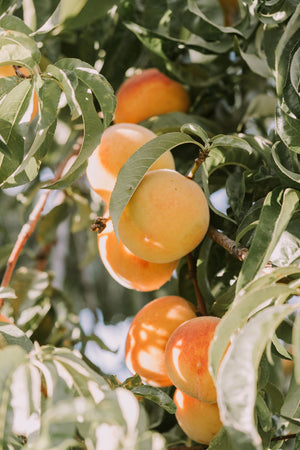
How To Use
Peach trees offer versatile options to enhance your landscape. Here are some recommendations based on their characteristics:
Fruitful Centerpiece: Peach trees have an appealing presence, making them an ideal choice as a central attraction in your landscape. Plant a single peach tree in an open area to showcase its elegant form and the promise of delicious fruit. Alternatively, create an eye-catching display by planting a group of peach trees together, creating a beautiful orchard-like focal point.
Shade Provider: With their expansive canopy, peach trees offer excellent shade. Position them thoughtfully near outdoor seating areas, patios, or decks to create a cool and comfortable space where you can relax and enjoy the outdoors during warm weather.
Windbreak and Privacy Screen: Peach trees, thanks to their sturdy growth and lush foliage, can also serve as effective windbreaks. Plant them in a row to shield your garden or home from strong winds, providing a natural barrier and protection. Their dense foliage can also be utilized to craft a natural privacy screen in your landscape. Plant them in a row along your property line to establish an attractive and functional boundary that enhances both privacy and aesthetics.
Fruitful Habitat: Peach trees contribute to the overall biodiversity of your garden by attracting various wildlife species. Birds and other animals are drawn to the fruit and shelter provided by peach trees. By planting peach trees, you can create a welcoming habitat and enjoy the sight and sounds of wildlife flourishing in your outdoor space.
When selecting peach trees for your landscape, consider their growth rate and environmental requirements. Ensure they are planted in areas that receive full sun and provide well-drained soil. With their elegant appearance and the promise of delicious, homegrown fruit, peach trees are an exceptional addition that enhances the beauty and functionality of your outdoor environment.
Conclusion
Peach trees are a captivating and versatile addition to any landscape. Their remarkable presence, distinctive fruit, and ecological significance make them a sought-after choice for various settings. By adhering to proper planting and care practices, you can enjoy the beauty and benefits of peach trees in multiple ways, whether it's creating a bountiful orchard or providing a fruitful haven in your garden. Whether you choose to showcase their delicious fruit as a focal point or incorporate them into a larger design, peach trees offer endless possibilities to enhance the allure of your outdoor space. With dedication and care, you can create a delightful landscape that will bring you lasting joy for years to come.

